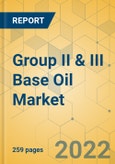Speak directly to the analyst to clarify any post sales queries you may have.
The report considers the present scenario of the group II & III base oil market and its market dynamics for 2022−2027. It covers a detailed overview of several market growth enablers, restraints, and trends. The study covers both the demand and supply sides of the market. It also profiles and analyses leading companies and several other prominent companies operating in the market.
The global group II & III base oil market is expected to reach USD 29.8 billion by 2027, growing at a CAGR of 6.7%.
KEY HIGHLIGHTS
- Globally, the market for group II & III base oil is intensifying due to the need for low sulfur content, low viscosity, and a higher saturation of chemical bonds that are effective in meeting the current market trends of reducing carbon footprint and improving fuel economy.
- In addition, stringent vehicle emission standards and high demand for lubricants are fuelling the market growth in recent years.
- API group II base oil is in a dominant phase while group III base oil is in the evolving phase and is primarily used in high-performance engines.
GLOBAL GROUP II & II BASE OIL MARKET SEGMENTATION
- From the technology perspective, hydrocracking is the dominant market segment.
- From the application perspective, automotive oil is the dominant segment as it consumes the major chunk of group II & III base oil, followed by industrial oil, process oil, and others.
Segmentation by Technology
- Hydrocracking
- Hydrotreating
- Catalytic Dewaxing
- Others
Segmentation by Application
- Automotive Oil
- Industrial Oil
- Process Oil
- Others
GEOGRAPHICAL ANALYSIS
- By 2027, APAC is expected to surpass North America in terms of group II & III base oil product revenue to become the leading group II & III base oil market globally. The market in APAC is predicted to witness the fastest growth during the forecast period with a CAGR of 7.47%, generating additional revenue of $5,778.03 million by 2027.
- In APAC, China, India, and Japan are the major consumers of group II & III base oil. Increasing GDP along with the growth of the automotive & transportation industry, and power generation activities has increased the demand for group II & III base oil.
Segmentation by Geography
- North America
- US
- Canada
- Europe
- Germany
- Russia
- France
- UK
- Spain
- Rest of Europe
- APAC
- China
- India
- Japan
- South Korea
- Rest of APAC
- Latin America
- Brazil
- Mexica
- Rest of Latin America
- Middle East & Africa
- Saudi Arabia
- UAE
- Iran
- Rest of the Middle East & Africa
VENDOR LANDSCAPE
The international players have been adopting an inorganic strategy to expand their footprint in the global market. It primarily involves mergers and acquisitions, expansion, and launching innovative products to strengthen their market position which significantly induces competition in the market. Mergers and acquisitions primarily benefit the companies by enabling better access to raw materials, production and distribution facilities, and R&D capabilities.
Key Vendors
- Chevron Corporation
- Exxon Mobil Corporation
- Hyundai and Shell Base Oil Co.
- Petro-Canada Lubricant
- Saudi Arabian Oil Co.
Other Prominent Vendors
- Asian Oil Company
- Abu Dhabi National Oil Company
- Chandri Wax Specialties Private Limited
- Dodge
- GS Caltex
- Hindustan Petroleum Corporation Limited (HPCL)
- HollyFrontier Corporation
- Mehta Petro Refineries Ltd
- Petroyag
- Resolute Oil
- Repsol
- SBZ Corporation
- Sinopec
- Shandong Qingyuan Group Co.
- Vertex Energy Inc
THE REPORT INCLUDES:
1. The Analysis of The Global Group II & II Base Oil Market Size and Growth Rate for The Forecast Period 2022-2027.
2. It Offers Comprehensive Insights into Current Industry Trends, Trend Forecast, And Growth Drivers About the Global Group II & II Base Oil Market.
3. The Report Provides the Latest Analysis of Market Share, Growth Drivers, Challenges, And Investment Opportunities.
4. It Offers a Complete Overview of Market Segments and The Regional Outlook of The Group II & II Base Oil Market.
5. The Report Offers a Detailed Overview of The Vendor Landscape, Competitive Analysis, And Critical Market Strategies to Gain Competitive Advantage.
Table of Contents
Companies Mentioned
- Chevron Corporation
- Exxon Mobil Corporation
- Hyundai and Shell Base Oil Co.
- Petro-Canada Lubricant
- Saudi Arabian Oil Co.
- Asian Oil Company
- Abu Dhabi National Oil Company
- Chandri Wax Specialties Private Limited
- Dodge
- GS Caltex
- Hindustan Petroleum Corporation Limited (HPCL)
- HollyFrontier Corporation
- Mehta Petro Refineries Ltd
- Petroyag
- Resolute Oil
- Repsol
- SBZ Corporation
- Sinopec
- Shandong Qingyuan Group Co.
- Vertex Energy Inc
Methodology
Our research comprises a mix of primary and secondary research. The secondary research sources that are typically referred to include, but are not limited to, company websites, annual reports, financial reports, company pipeline charts, broker reports, investor presentations and SEC filings, journals and conferences, internal proprietary databases, news articles, press releases, and webcasts specific to the companies operating in any given market.
Primary research involves email interactions with the industry participants across major geographies. The participants who typically take part in such a process include, but are not limited to, CEOs, VPs, business development managers, market intelligence managers, and national sales managers. We primarily rely on internal research work and internal databases that we have populated over the years. We cross-verify our secondary research findings with the primary respondents participating in the study.

LOADING...








